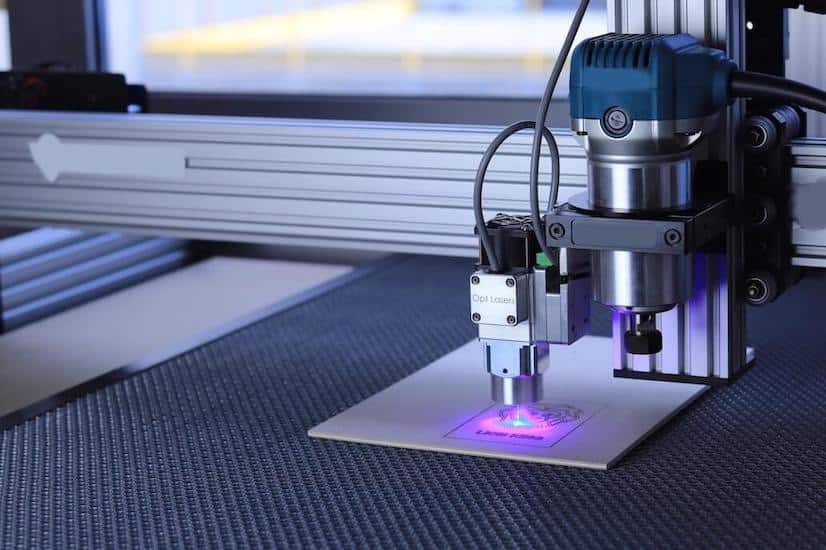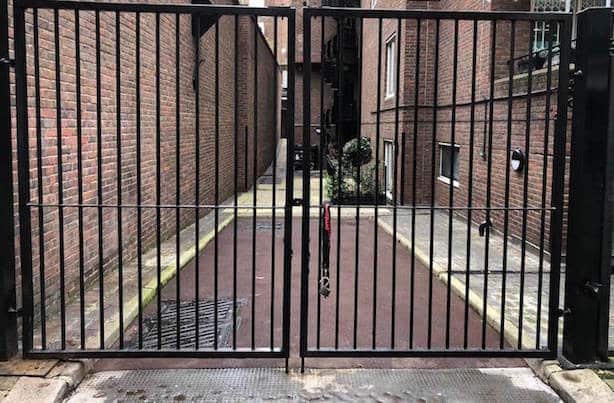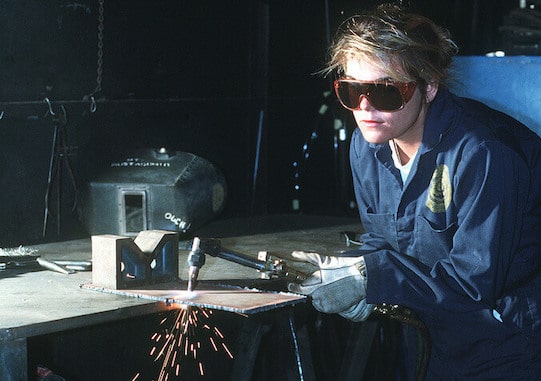Metal Cutting
Metal cutting is a process of separating larger piece of metal material into smaller pieces. There are several metal cutting methods available. Each with its unique advantages and limitations suitable for different fabrication projects.

Metal Cutting Methods
Sawing
Sawing uses a saw blade to cut material into manageable sizes or specific shapes. This cutting method offers close tolerance cutting, fast cutting speeds, and high cut quality. Sawing is used in most of the industries.
Laser Cutting
Laser cutting is a metal cutting method that uses high-powered focused beams of light. The beams are then used to heat, melt, and cut through materials without touching them. This cutting method is highly precise and accurate. Making it ideal for fabricating parts and products in a range of industries. Laser cutting is used in fields like aerospace, architecture, biotech, chemical, food processing, marine, packaging, and pharmaceuticals.
Water jet Cutting
Water jet cutting uses pressurized water to cut materials into the desired shape and size. The high-pressure streams of water can have added abrasives like aluminum oxide or garnet to aid the cutting process. Water jet Cutting is often used for cutting thicker and harder materials. Water jet cutting is a great way to make parts for different industries, like engines, control panels, pipes, and pumps for planes, boats, and more.
Shearing
Shearing is a cutting method that uses a moving blades. An upper blade and a stationary lower blade slightly offset to cut materials. Shearing is a versatile method, allowing operators to bend, punch, and press metal materials. This is ideal for cutting thicker metals and making products for industries such as automotive, construction, and electrical.
Shearing can be used to cut metal in either a straight line or at an angle. In the process of metal fabrication, shearing is used to break up big chunks of metal into smaller, easier-to-handle pieces.
Sheet metal cutting
Cutting sheet metal is a process used in sheet metal fabrication.
To cut sheet metal, powerful cutting edges are applied to the material with a lot of power to remove specific parts. This process is known as sheet metal cutting.
This process is performed through a shearing force. It is applied via die blades which are used to cut the material at the right angle. When cutting sheet metal, the material is placed between two parts of the cutting mechanism. The punch on top and the die on the bottom.
The appropriate level of clearance recommended varies based on a range of factors. Some of which are the thickness of the sheet metal, the type of cutting operation, and other pertinent aspects. There are several types of sheet metal cutting operations such as punching, shearing, trimming, blanking and deburring. Each operation is used for specific purposes. The process of punching entails removing a relatively small section of material from a sheet metal component. Blanking is utilized to produce small details by cutting out an enclosed part of a sheet metal piece.
The Best Metal Cutting Method
The most suitable metal cutting method for your project will depend on the type of metal being used, the required level of precision, and your budget for the project.
The right cutting method can achieve:
- Reduced amount of generated waste.
- Increase of production efficiency and speed.
- High-quality products at lower costs.

Metal Cutting: Mechanics and Frictional Interaction
In metal cutting, a wedge-shaped tool is utilized to trim away excess material from a workpiece. The contact between the chip and the tool is fundamental in determining the mechanics of metal cutting. That includes deformation, cutting forces, and energy consumption. The friction between the chip and the tool has a major influence on tool wear. As well as the performance of cutting fluids, and the quality of the machined surface. To model the cutting process, it is essential to have a thorough comprehension of the friction at the tool rake surface.
Environmental Concerns with Cutting Oils
Machining or cutting oils are commonly used for the process of metal cutting. Which can result in significant waste. The waste may contain metal dusts and similar contaminants, posing a hazard to the environment.
Metal Forming Processes: Advancements and Trends
Metal forming processes are among the most widely used manufacturing technologies. Metal forming is a process that can create parts with complicated shapes, strong yet lightweight structures, and other great features. Nowadays, the focus in metal forming is to make it cheaper, faster, and better in terms of the quality of the final product. In the recent decades there’s been a huge development of new materials and techniques. This has led to a lot of progress in metal forming technology.
Metal Forming Processes and Fluid Usage
Metal forming is a key process in the metal fabrication industry. It involves shaping a workpiece through plastic deformation. It can be classified by product, material, forming temperature, and nature of deformation. However, the boundaries between categories are not perfectly defined. Cutting fluids play an important role in metal removal operations. There are however strong economic and environmental incentives for reducing their use. Precision near-net part casting and forming operations may reduce metal cutting requirements and fluid usage. New “dry” machining materials and processes may also reduce fluid use. As we move forward, the use of cutting fluids may become more influenced by environmental concerns.
Laser Cutting of Metals: Power Requirements
The use of lasers for cutting metal requires higher average power compared to the cutting of non-metallic materials. This is because metal surfaces have higher conductivity and reflectivity. Which necessitates the need for greater power. To meet these power requirements, most metal cutting applications are performed with CO2 lasers. Oxy cutting is also often used for metal cutting, as it can increase the cutting speed by up to 40% when compared to using other gases.
Advantages of Laser Cutting
Laser cutting has several advantages over other cutting processes. These include minimal kerf, noncontact process, no tool setup and storage costs, and superior cut edges.
Metal cutting companies
Metal cutting companies offer precision cutting services to produce tight tolerance, burr-free parts. They provide custom metal cutting services, including lapping, polishing, finishing, grinding, and machining.
Industries
Metal cutting companies serves a variety of industries that demand high precision in their work. These industries include medical, electronic, automotive, biotech, semiconductor, aerospace, fiber optic, and electrical. Using the newest technology and knowledge from metal cutting companies can give industries a big advantage over their rivals. This helps them achieve better outcomes and stay ahead in the market.
Competence
Companies specializing in metal cutting should possess the necessary skills, equipment, and materials (e.g. tubing, rods, and wires). Good metal cutting companies should deliver on both small and large orders, precise measurements, excellent finishes, and very narrow margins of error. They display their expertise and experience in their product offerings that cater to their diverse clientele.
Specialty Refractory Metals
Niche metal cutting businesses use different refractory metals. Such metals include tungsten and molybdenum. These metals are available in various combinations, sizes, and finishes. They come in the form as wires, rods, and ribbons.
Some Metal cutting businesses can also provide electrodes for resistance spot welding and die sinker EDM applications.

Metal Cutting Service In London
Mobile Welding London is a UK-based welding and metal fabrication company.
We provide metal cutting services throughout Greater London and the suburbs.
Our team has over 20 years of experience with on-site welding and metal fabrication works. Our services are available for both commercial and residential clients in London.
We can help with mobile cutting services at your location as well as in a workshop. The services cover laser cutting, and sheet metal fabrication services for a variety of materials. Our metal cutting service can handle mild steel, stainless steel, brass, and aluminum.
Access to the latest tools ensures we provide you with efficient cutting.
We also supply install and repair:
- Security gates.
- Structural steel.
- Railings.
- Balusters.
- Fencing.
- Metal staircase repairs.
- Boat welding repairs.
- Trailers and caravans.
- Plant and equipment welding.
- Pipe welding.
- Gym equipment welding.
- Cutting.
- Oxy cutting.
- Drilling.
- Welding.
- Fabrication of metal structures.
- Fabrication.
- Mobile welding.
- Architectural metalwork.
- Coded pipe welding and installation.
- Structural steel.
- Custom artwork.
- Stock supplier.
We use welding methods like Stick Welding, MIG Welding, Tig Welding, Oxy cutting, Plasma cutting, and more.
Why Choose Us
- A fixed-price quotes to cover the entire project.
- Certified and fully insured works.
- Comply with health and safety regulations.
- Fast response service.
- Up to 18 months guarantee.
- Experienced and reliable Metal cutters.
- Top rated local welding company.
- Exceptional work quality.
- Affordable rates.
Contact us for on-site welding, fabrication, metal cutting, or sheet metal folding. We have a welder near you and will get your project completed to your satisfaction.
